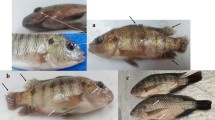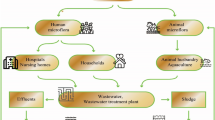Abstract
Lack of access to potable water has forced many inhabitants of informal settlements in South Africa to rely on surface water sources for their daily water needs, thus exposing these communities to microbial contamination that can result in water-borne diseases. These water sources also serve as natural habitats of pathogenic E. coli strains which harbour virulence factors, which could play a role in the disease process, as well as various multi-drug resistant water-borne pathogens. This study investigated the microbiological quality of two river waters in Durban, South Africa, using total coliform and faecal coliform population as indices. The virulence markers and antibiogram profiles of the E. coli isolates from these rivers were also determined. The results indicated that water from these river sources were of poor microbiological quality and unfit for human consumption. Antibiotic Resistance Profiles of the isolates revealed that 97.1% of the Palmiet River isolates and 71.15% of the Umgeni River isolates were multi-resistant to the antibiotics tested, with all the isolates found to be resistant to novobiocin. Characterization of the virulence markers revealed the presence of stx1, cnf1 and eaeA genes, indicating the possible health risk associated with the ingestion of water from these rivers. The inherent health risks associated with the use of these river water emphasises the need for safe water supply and provision of proper sanitation facilities for the inhabitants of the informal settlements along these river banks.

Similar content being viewed by others
References
Ahmed W, Tucker J, Bettelheim KA, Neller R, Katouli M (2007) Detection of virulence genes in Escherichia coli of an existing metabolic fingerprint database to predict the sources of pathogenic E. coli in surface waters. Water Res 41:3785–3791
Al-Ghazali MR, Jazrawi SF, Al-Doori ZA (1988) Antibiotic resistance among pollution indicator bacteria isolated from Al-Khair River, Baghdad. Water Res 22:641–644
Al-Jebouri MM (1985) A note on antibiotic resistance in the bacterial flora of raw sewage and sewage-polluted river Tigris in Mosul, Iraq. J Appl Bacteriol 58:401–405
Ash RJ, Mauck B, Morgan M (2002) Antibiotic resistance of Gram negative bacteria in rivers. Emerging Infect Dis 8:7–12
Britton LJ, Greeson PE (eds) (1987) Methods for collection and analysis of aquatic biological and microbiological samples, p 363. U.S. Geological Survey Techniques of Water-Resources Investigation, chap A4
Buckalew DW, Hartman LJ, Grimsley GA, Martin AE, Register KM (2006) A long-term study comparing membrane filtration with Colilert defined substrates in detecting faecal coliforms and Escherichia coli in natural waters. J Environ Managt 80:191–197
Coker AO, Adefeso AO (1994) The changing patterns of Campylobacter jejuni/coli in Lagos, Nigeria after ten years. East Afr Med J 71:437–440
Department of Water Affairs and Forestry (DWAF) (1996) South African water quality guidelines 2: recreational water use, vol 2. Department of Water Affairs and Forestry, Pretoria
Department of Water Affairs and Forestry (DWAF) (1998) Quality of domestic water supplies—vol 1, assessment guide. Department of Water Affairs and Forestry, Pretoria
Edward PR, Ewing WH (1972) Identification of Enterobacteriaceae, 3rd ed. International Student Publication, Burgess, pp 26–28
El-Sheikh SM, El-Assouli SM (2001) Prevalence of viral, bacterial and parasitic enteropathogens among young children with acute diarrhoea in Jeddah, Saudi Arabia. J Health Pop Nutr 19:25–30
Engberg J, Aerestrup FM, Taylor DE, Gerner-Smidt Nachamkin (2001) Quinolone and macrolide resistance in Campylobacter jejuni and Campylobacter coli: resistance and trends in human isolates. Emerg Infect Dis 7:24–34
Falagas M, Gorbach S (1995) Practice guidelines: urinary tract infections. Infect Dis Clin Pract 4:241–257
Fatoki OS, Muyima NYO, Lujiza N (2001) Situation analysis of water quality in the Umtata River catchment. Water SA 27:467–473
Forbes BA, Sahm DF, Weissfeld AS (1998) Diagnostic microbiology, vol 10. Mosby, St. Louis, pp 384–388
Furuya YE, Lowy FD (2006) Antimicrobial-resistant bacteria in the community setting. Microbiol Nature Rev 4:36–45
Galane PM, Le Roux M (2001) Molecular epidemiology of Escherichia coli isolated from young South African children with diarrhoeal diseases. J Health Pop Nutr 19:31–37
Goni-Urriza M, Capdepuy M, Arpin C, Raymond N, Caumette P, Quentin C (2000) Impact of an urban effluent on antibiotic resistance of riverine Enterobacteriaceae and Aeromonas spp. Appl Environ Microbiol 66:125–132
Hoge CW, Gambel JM, Srijan A, Pitarangsic C, Echevervia P (1998) Trends in antibiotic resistance among diarrhoeal pathogens isolated in Thailand over 15 years. Clin Infect Dis 26:341–345
Holt-Harris JE, Teague O (1916) A new culture medium for the isolation of Bacillus typhosa from stools. J Infect Dis 18:596
Huang DB, Mohanty A, DuPont HL, Okhuysen PC, Chiang T (2006) A review of an emerging enteric pathogen: enteroaggregative Escherichia coli. J Med Microbiol 55:1303–1311
Igbinosa EO, Okoh AI (2009) Impact of discharge wastewater effluents on the physico–chemical qualities of a receiving watershed in a typical rural community. Int J Environ Sci Tech 6:175–182
Kobori D, Rigobelo EC, Macedo C, Marin JM, Avila FA (2004) Virulence properties of shiga toxin-producing Escherichia coli isolated from cases of bovine mastitis in Brazil. Revue Élev Méd vét Pays trop 57:15–20
Kroening SE (1999) Faecal Coliform and Escherichia coli Bacteria in the St. Croix National Scenic Riverway, Summer. Water-Resources Investigations Report, 00-4214 U.S. Geological Survey, p 1–8
Kuhnert P, Boerlin P, Frey J (2000) Target genes of virulence assessment of Escherichia coli isolates from water, food and the environment. Fed Europ Microbiol Soc Rev 24:107–117
Leclerc H, Mossel DAA, Edberg SC, Struijk CB (2001) Advances in the bacteriology of the coliform group: their suitability as markers of microbial water safety. Ann Rev Microbiol 55:201–234
Lehloesa LJ, Muyima NYO (2000) Evaluation of impact of household treatment procedures on the quality of groundwater supplies in the rural community of the Victoria District, Eastern Cape. Water SA 26:285–290
Lo Presti F, Riffard S, Jarraud S, Legallou F, Richet H, Vandenesch F, Etienne J (2000) Isolation of Legionella oakridgensis from two patients with pleural effusion living in the same geographical area. J Clin Microbiol 38:3128–3130
Martinez JL, Baquero F (2002) Interactions among strategies associated with bacterial infection: pathogenicity, epidemicity, and antibiotic resistance. Clin Microbiol Rev 15:647–679
McEwen SA, Fedorka-Cray PJ (2002) Antimicrobial use and resistance in animals. Clin Infect Dis 34:93–106
Mellon M, Benbrook C, Benbrook K (2001) Hogging it: estimates of antimicrobial abuse in livestock. UCS Publications, Cambridge
Müller EE, Ehlers MM, Grabow WOK (2001) The occurrence of E. coli O157:H7 in South African water sources intended for direct and indirect human consumption. Water Res 35:3085–3088
Nataro JP, Kaper JB (1998) Diarrhoeagenic Escherichia coli. Clin Microbiol Rev 11:142–201
National Committee for Clinical Laboratory Standards (NCCLS) (2000) Performance standards for antimicrobial disk susceptibility tests. NCCLS document M2-A7. National Committee for Clinical Laboratory Standards, Wayne
Nevondo TS, Cloete TE (1999) Bacterial and chemical qualities of water supply in Dertig Village Settement. Water SA 25:215–220
Obi CL, Coker AO, Epoke J, Ndip RN (1998) Distributional pattern of bacterial diarrhoeagenic agents and antibiograms of isolates from diarrhoeic and non-diarrhoeic patients in urban and rural areas of Nigeria. Cent Afr J Med 44:223–229
Obi CL, Potgieter N, Bessong PO, Matsaung G (2002) Assessment of the microbial quality of river water sources in rural communities in South Africa. Water SA 28:287–292
Obi CL, Green E, Bessong PO, de Villiers B, Hoosen AA, Igumbor EO, Potgieter N (2004a) Gene encoding virulence markers among Escherichia coli isolates from diarrhoeic stool samples and river sources in rural Venda communities of South Africa. Water SA 30:37–41
Obi CL, Bessong PO, Momba MNB, Potgieter N, Samie A, Igumbor EO (2004b) Profiles of antibiotic susceptibilities of bacterial isolates and physico-chemical quality of water supply in rural Venda communities, South Africa. Water SA 30:515–519
Orsi RH, Stoppe NC, Inês ZSM, Gomes TAT, Prado PI, Manfio GP, Ottoboni LMM (2007) Genetic variability and pathogenicity potential of Escherichia coli isolated from recreational water reservoirs. Res Microbiol 158:420–427
Pandey S (2006) Water pollution and health—review article. Kathmandu Univ Med J 4:128–134
Ram S, Vajpayee P, Shanker R (2008a) Contamination of potable water distribution system by multi-antimicrobial resistant enterohaemorrhagic Escherichia coli. Environ Health Perspect 116:448–452
Ram S, Vajpayee P, Tripathi U, Singh RL, Seth PK, Shanker R (2008b) Determination of antimicrobial resistance and virulence gene signatures in surface water isolates of Escherichia coli. J Appl Microbiol 105:1899–1908
Ram S, Vajpayee P, Singh RL, Shanker R (2009) Surface contamination of a perennial river exhibits multi-antimicrobial resistant shiga toxin and enterotoxin producing Escherichia coli. Ecotoxcol Environ Safety 72:490–495
Schroeder CM, Zhao C, DebRoy C, Torcolini J, Zhao S, White DG, Wagner DD, McDermott PF, Walker RD, Meng J (2002) Antimicrobial resistance of Escherichia coli O157 isolated from humans, cattle and swine food. Appl Environ Microbiol 68:576–581
Schubert S, Rakin A, Karch H, Carniel E, Heesemann J (1998) Prevalence of the ‘high-pathogenicity island’ of Yersinia species among Escherichia coli strains that are pathogenic to humans. J Infect Immun 66:480–485
Snyder JD, Merson MH (1982) The magnitude of the global problem of acute diarrhoea disease: a review of active surveillance data. Bull World Health Org 60:603–613
Venter SN (2001) Microbial water quality in the 21st century. SA Water Bull 27:16–17
Wasfy MO, Oyofo BA, David JC, Ismail TF, El-Gendy AM, Mohran ZS, Sultan Y, Peruski LF (2000) Isolation and antibiotic susceptibility of Salmonella, Shigella and Campylobacter from acute enteric infections in Egypt. J Health Pop Nutr 18:33–38
White DG, Hudson C, Maurer JJ, Ayers S, Zhao S, Lee MD, Bolton L, Foley T, Sherwood J (2000) Characterization of chloramphenicol and florfenicol resistance in Escherichia coli associated with bovine diarrhoea. J Clin Microbiol 38:4593–4598
Wilkes G, Edge T, Gannon V, Jokinen C, Lyautey E, Medeiros D, Neumann N, Ruecker N, Topp E, Lapen DR (2009) Seasonal relationships among indicator bacteria, pathogenic bacteria, Cryptosporidium oocysts, Giardia cysts, and hydrological indices for surface waters within an agricultural landscape. Water Res 43:2209–2223
Zamxaka M, Pironcheva G, Muyima NYO (2004) Microbiological and physico-chemical assessment of the quality of domestic water sources in selected rural communities of the Eastern Cape Province, South Africa. Water SA 30:333–340
Acknowledgments
The Authors would like to thank Prof. U. Reischl (Institute of Medical Microbiology and Hygiene, University of Regensburg, Germany) for the kind supply of DNA samples of positive control E. coli strains used in this study. This study was supported by the National Research Foundation and Water Research Commission of South Africa and the University of KwaZulu-Natal, Durban, South Africa.
Author information
Authors and Affiliations
Corresponding author
Rights and permissions
About this article
Cite this article
Olaniran, A.O., Naicker, K. & Pillay, B. Antibiotic resistance profiles of Escherichia coli isolates from river sources in Durban, South Africa. World J Microbiol Biotechnol 25, 1743–1749 (2009). https://doi.org/10.1007/s11274-009-0071-x
Received:
Accepted:
Published:
Issue Date:
DOI: https://doi.org/10.1007/s11274-009-0071-x




